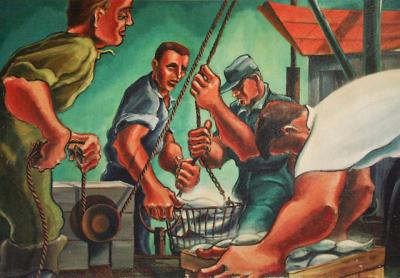Kenneth Bonar Walsh Exhibition at Town Hall

The East Hampton Arts Council has chosen works by Kenneth Bonar Walsh, who lived and worked in Montauk in the 1960s and ’70s, for an exhibition at Town Hall.
Works not seen by the public in nearly a half-century will be prominent in the exhibition, the fourth on the South Fork to feature Walsh’s work over the last 18 months. The works included, all from the early and mid-1960s, are mostly watercolors, all created in Montauk. Along with seascapes and the iconic lighthouse, subjects include buildings, boats, and fishermen at Gosman’s Dock, where the artist painted and exhibited work at his Bonart Gallery.
Walsh’s soft-realist style is evocative. When a selection of his watercolor paintings were on display at the Amagansett Public Library in May 2017, one visitor wrote that she felt herself “transported back through time, standing before the subjects themselves.”
Born in Medford, Mass., the World War II veteran attended art school on the G.I. Bill before moving to New York City, where he worked in the art department at Lever Brothers. He later established a commercial art studio, finding success with clients including RCA Records, Transogram Toys, and the Schrafft’s candy and chocolate company.
The artist, who loved fishing as a youth, discovered Montauk in the 1950s and eventually built a house in Hither Hills. During this time he also developed as a painter. The realism of his works depicting Manhattan and Montauk — St. Mark’s Church in-the-Bowery, the Old Hook Mill in East Hampton, the lighthouse — evolved into stylized, impressionist portraits of self, a boy on the Central Park Carousel, and fishermen at work. A more curvaceous, softer realism developed, accentuating the muscular hands and forearms of the fishermen.
Along with paintings, Walsh also produced works such as an antique-style map of Montauk (to be featured at Town Hall), a children’s book (“The Littlest Fishing Boat”), and other Montauk-related merchandise.
Later, in the 1970s, his work evolved again, now a modernist, abstract style in which nearly all the lines were curves running the breadth of one or more figures, defining several features of a figure, as well as the boundaries between and interpenetrations of figures, often in a yin-yang symmetry of opposites. An example of this period — “Jonathan,” depicting one of the artist’s sons fishing at Montauk Harbor — is included in the exhibition.
Another son, Christopher Walsh, a senior writer at The Star, curated the exhibition and is the archivist of his father’s work.
